All photos by Ashli Blow
On his tribe’s land, enveloped by the state of Oregon, Jesse Jackson stood at the threshold between two ecosystems: On one side of him, an open canopy bathed grasses and white oak trees in sunlight; on the other, a thick cover of evergreen trees darkened the landscape.
A forget-me-not wildflower bloomed in the clearing. This is where the Cow Creek Band of Umpqua Tribe of Indians have been restoring their oak savanna meadows, after decades of fire suppression and the removal of large, fire-adapted trees under federal management.
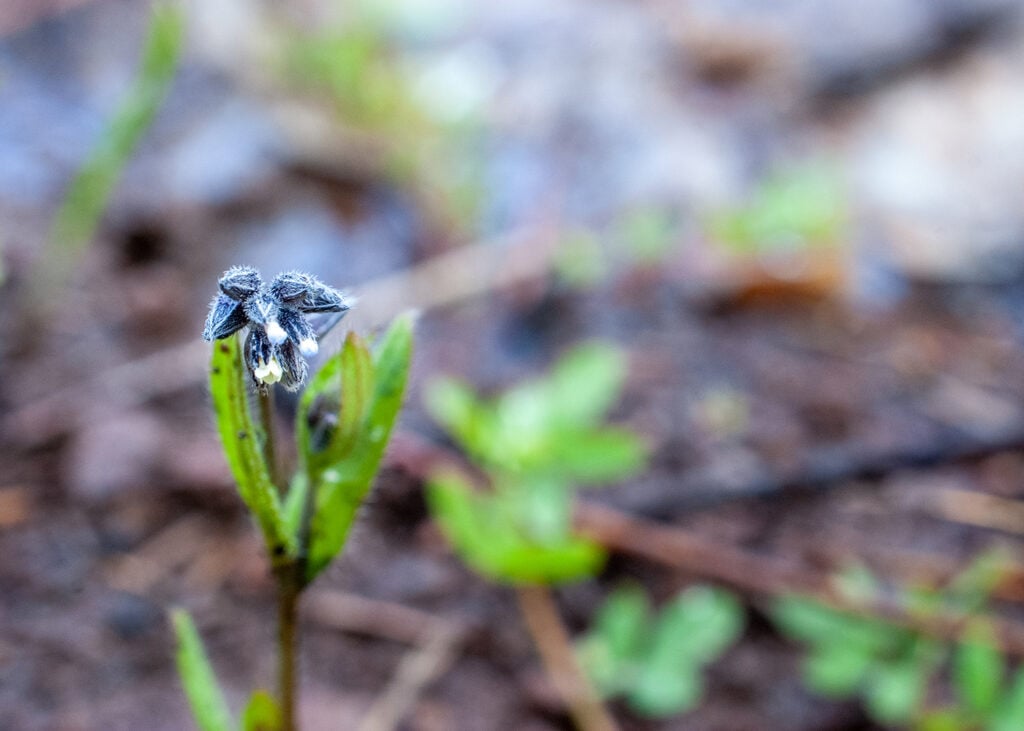
A small forget-me-not flower before it blooms grows on the edges of the conifer tree stands, near the restoration work of the oak savanna meadows.
In addition to land they bought from private owners, in 2018, the Tribe received 17,519 acres of land from the U.S. government for the Tribe to manage under its own authority. This came as part of the Western Oregon Tribal Fairness Act; this bipartisan legislation sought to put tribal lands in trust in order to return the restoration of these lands—and the related economic activity and job development they created—to the Cow Creek Umpqua and the Confederated Tribes of Coos, Lower Umpqua, and Siuslaw Indians.
The Cow Creek Umpqua government hired foresters to study the landscape, which was dotted with decades-old Douglas fir stumps from clearcuts. They discovered that before the area had been overtaken by conifers, it was historically an oak savanna meadow, a pocket in the Willamette Valley that stretches the length of the Cascade Mountains and the Oregon Coast Range. This finding matched Tribal elders’ stories about a time when game was abundant, and grasses thrived as the tribe practiced cultural burning.
“We are not living the way that we want to live,” says Jackson, Cow Creek Umpqua member and education coordinator for the tribe. His ancestors, the Nahánkʰuotana, moved seasonally between homes in the foothills and in the valley. When leaving their summer camps in the foothills of the Cascades, or Umpqua mountains, they would burn the land before moving down to their winter camps at lower elevations. They did the same when coming back up as the weather warmed. The Nahánkʰuotana would return to each place to find healthy soils enriched by the charcoal left from the fire, which came from burned wood and plant debris that acted as a natural fertilizer.
“We are a burn culture,” Jackson says. “We would say that we burned here since time immemorial. Anthropologists or archaeologists would say that we burned here 20,000 to 40,000 years.”
In any case, Jackson says, the feds have “messed up” that legacy in the past 200 years by not continuing these age-old land practices.
The U.S. Forest Service’s fire suppression policies began in the early 1900s and contribute to the tribe’s current struggle with wildfires that burn larger, hotter, and out of control. To reduce this risk—to both the Tribe and the nearby city of Roseburg, Oregon—and to revitalize their cultural resources, Cow Creek Umpqua is blending Western science with traditional ecological knowledge to manage the landscape and safely reintroduce fire. Despite the challenges posed by climate change in finding suitable conditions for burning, outcomes from the managed areas so far are promising.
But to bring fire back, they first needed their land back.
The Knowledge to Thrive
Despite the historic theft of the Tribe’s land, many members, like Jackson’s ancestors, never left.
When the Treaty of 1853 was signed, the Cow Creek Umpqua viewed it as a government-to-government agreement between two sovereign nations. In exchange for land “ownership,” the U.S. government would provide the Tribe with health care, housing, and education. However, the U.S. government didn’t follow through on its promises. Rather, it claimed more than 500,000 acres of Cow Creek Umpqua’s land, and while the agreement was to pay the Tribe just $0.02 per acre—a fraction of the $1.25 per acre the government charged settlers who quickly moved in—the Cow Creek Umpqua say they never received even this low sum.
Many people of Cow Creek Umpqua resisted the U.S. government’s efforts to relocate them to reservations, and instead lived in seclusion. They held onto their culture and continued to hold council meetings as they had for countless generations.
In 1954, the Cow Creek Umpqua pursued justice with the U.S. government. After being forcibly terminated under the Western Oregon Indian Termination Act, the Tribe filed a land claims case, resulting in its recognition as a sovereign tribal government and a $1.5 million settlement in the 1980s.
In the following decades, the Tribe started buying its land back. In 2018, the Bureau of Land Management returned around 3% of the Cow Creek Umpqua’s ancestral lands under the Western Oregon Tribal Fairness Act. It was returned in trust, meaning the federal government holds legal title, but the beneficial interest remains with the Tribe. Elected leaders who supported the passage of the law called it an “encouraging move toward progress” in righting the injustices toward Indigenous peoples.
Then, in 2019, a wildfire came through.
The Milepost 97 wildfire destroyed nearly a fourth of what was returned to the tribe: 3,634 of their 17,519 acres. The fire raged when it reached the burn scar of the 1987 Canyon Mountain wildfire. Years’ worth accumulated snags and thick brush prevented firefighters from quickly accessing the area and added dangerous fuel to the flames.
“When I first went up there, it was like an atomic bomb had gone off,” Cow Creek Umpqua Chairman Carla Keene recalled this year. “The trees were gone. It was just black, and it was just the most depressing sight I’d ever seen.”
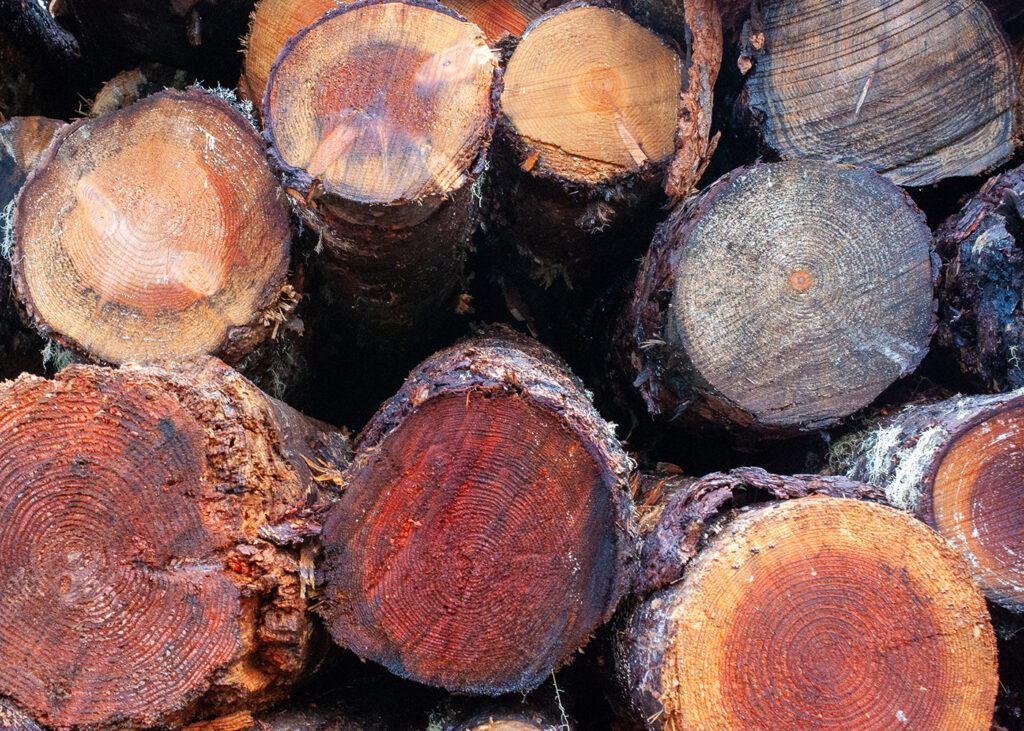
Logs from a forest restoration project await removal as part of Tribal efforts to reduce fire hazards and promote ecosystem recovery.
The Cow Creek Umpqua Tribal Board of Directors resolved to restore the forest, initiating efforts to salvage and repurpose the charred logs. Today, that lumber is showcased in the construction of the Portland International Airport and the Tribe’s remodeled government office. These structures display the tribe’s principle that forests and people are meant to have a hands-on connection.
“For people that have not had their voices heard at many tables for a long time, our [Tribal] voice is starting to be heard and starting to be cherished,” Jackson says. “You’re starting to see Western scientific knowledge and traditional ecological knowledge start to do this, like they should.”
After the fire, the Tribe hired Wade Christensen, an enrolled member of Choctaw Nation, as a forester. He was trained in silviculture—a practice focused on managing forest health and growth to meet specific land management objectives, such as ecosystem restoration through thinning and burning. He creates detailed maps and work plans focused on cultivating the oak savanna and reducing the conifer monocultures that had been introduced for timber.
To make this happen, Christensen coordinates closely with the Forest Service and neighboring landowners for prescribed burns. Foresters like Christensen refer to it as a “prescription” because, much like a doctor treating a sick patient, they are writing a plan to restore the land to health.
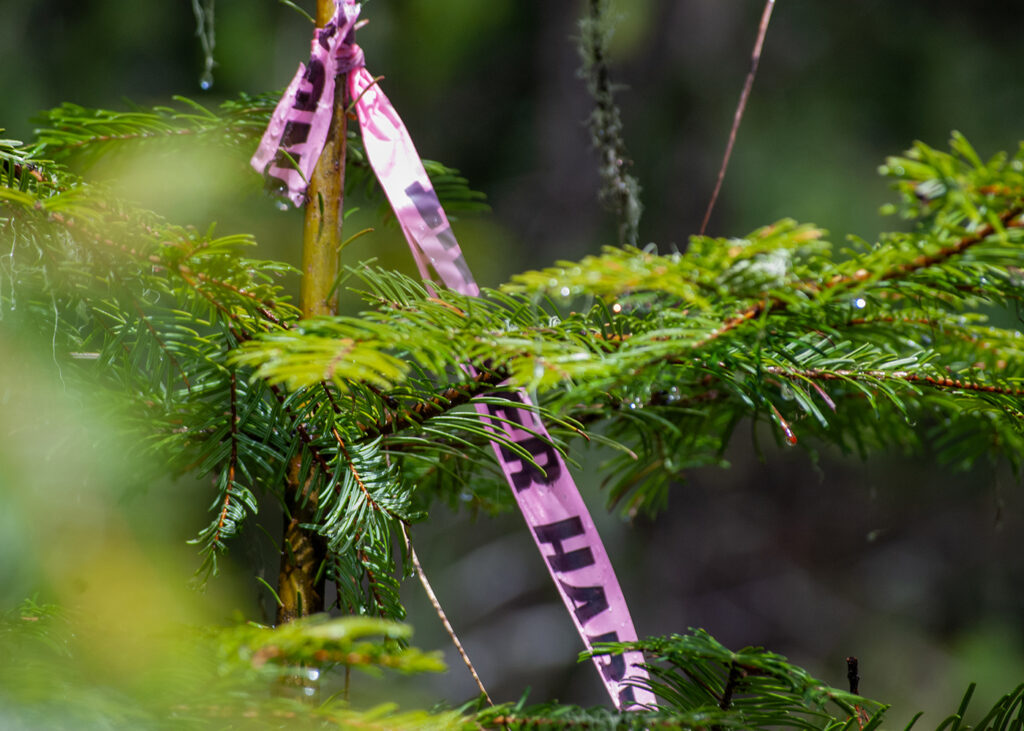
A pink ribbon designates a tree under consideration for removal, as part of prescribed fire and thinning efforts to reduce fire risk.
Early in his time working for the Tribe, Christensen was following a prescription on land the Tribe had purchased from a timber company. As he began marking trees for removal, he quickly realized the plan didn’t account for the meadow ecoregion. Within it were Oregon white oak trees, a species with thick bark that can survive fire. Moving forward, he knew he had to adapt. He worked to gain a deeper understanding of the landscape, not only to reduce wildfire risk, but also to promote cultural resources like berries, native grasses, and medicinal plants that flourish in recently burned soil and under an open canopy.
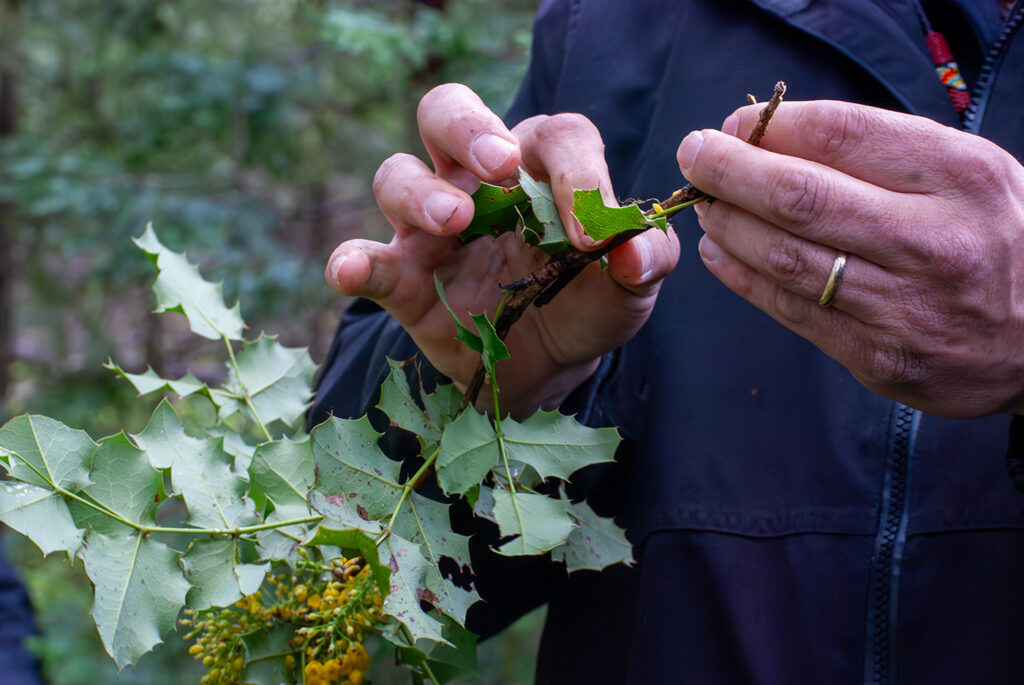
Jackson holds Oregon grape-holly, a plant with a variety of medicinal uses, that he picked near the Grandmother Tree.
“I’ve got this understanding of the benefits of burning in the forest, and I’m all in on prescribed burning,” says Christensen, who has a degree from University of Oregon in sustainable forest management, “and I work for a Tribe, so I’m learning why it is important to the Tribe.”
That learning is ongoing. Christensen recalls hearing a speaker at a conference say that he knows to light the trees when the acorns drop: “I was like, I am not at that man’s level.”
Christensen was listening to Frank Lake, a Karuk Tribal descendant and leading research ecologist with the Forest Service’s Southwest Station, who explores social-ecological frameworks to understand the impact of colonization—like fire suppression policies—on tribal access and forest resource quality. Lake’s research underscores that building trust and sharing knowledge through collaboration between federal agencies and tribal nations is essential, something Christensen understands well.
“You really got to dig deep with these guys and spend a lot of time with them,” Christensen says. “I’m using [fire] for fuels reduction, and hopefully I do things right, and we have other benefits. I am trying to get to where I understand where we can apply it to help a plant that we gather off of, but that takes time, and that takes a lot of conversation.”
Healing Cultures and Landscapes
In an era of climate change, government agencies across the U.S. are increasingly recognizing the need to actively apply traditional ecological knowledge to mainstream land management practices—balancing these institutions’ often short-term, extractive values with an intergenerational perspective.
To mobilize, the National Science Foundation invested $30 million to launch its Center for Braiding Indigenous Knowledge and Sciences last year. The center has set up hubs from the Pacific Islands to the Northeastern United States.
Leaders in the Land Back Movement have relied on a limited set of policy tools. For example, the Department of the Interior placed the National Bison Range in trust for the Confederated Salish and Kootenai Tribes, a similar trust structure that returned land management to Cow Creek Umpqua. There’s also co-management agreements—like Forest Service stewardship deals with tribes in the Midwest and Western states—and conservation easements—like the one Oakland used to place a parcel of land in the hands of the Ohlone people.
Critics argue that while these actions may return land to tribes, they often do so under federal, state, and municipal terms that restrict the tribes’ autonomy in managing their lands.
That’s where purchasing lands outright comes in—a strategy the Penobscot Nation used in 2022 when nearly 30,000 acres of private forest lands went up for sale in Maine. The Nation worked with Trust for Public Land, securing loans and initiating a $32 million fundraising effort to pay them off. Trust for Public Land, a nonprofit organization focused on expanding outdoor access, has collaborated with more than 70 tribes and Indigenous groups to help them acquire and preserve their homelands and culturally significant sites. The organization tries to facilitate a tribe or nation’s right to self-governance. To do so, it has adopted internal policies that don’t require legal agreements that limit land use to conservation.
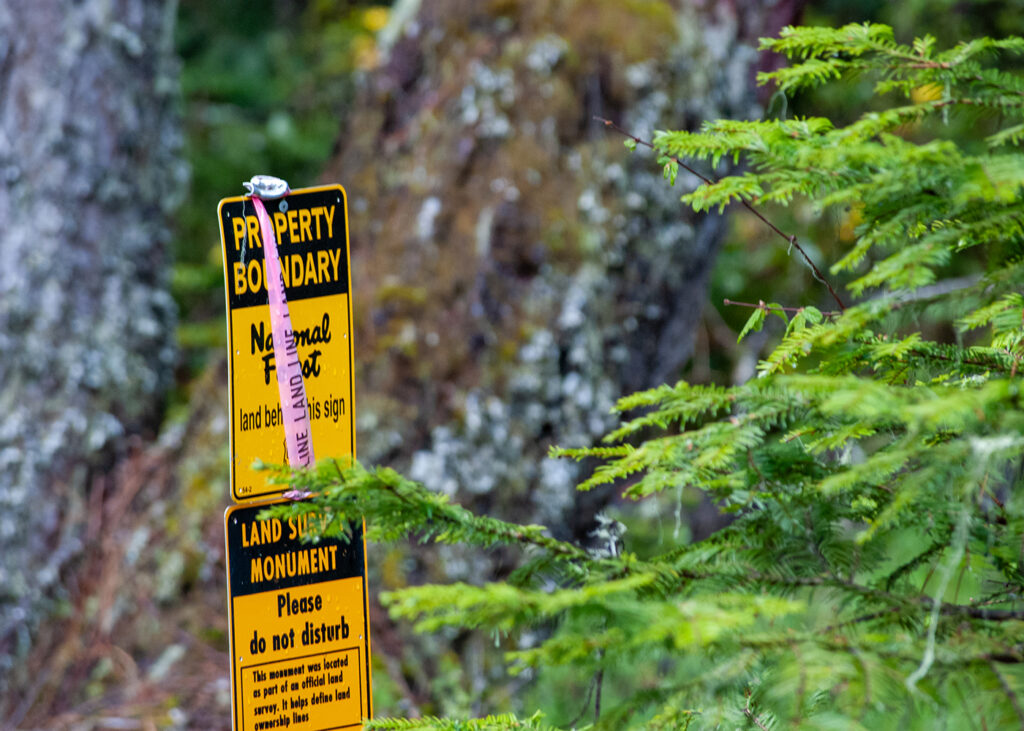
A yellow National Forest sign marks the boundary between Cow Creek Umpqua tribal lands and the adjacent USFS land.
“When you impose restrictions or conservation easements or those types of things on the property, then you’re really not supporting the tribal sovereignty,” says Ken Lucero, director of tribal and indigenous lands at Trust for Public Land.
Lucero is a member of the Pueblo of Zia, who historically practiced dry farming and waffle gardening, which harnesses the little bit of rain that falls in the Southwest desert.
“By having Indigenous knowledge and land back be at the center of the new definition of conservation, then we have a lot of good things that can come of that,” he says. “If we can put land back, land return, and Indigenous knowledge at the center of conservation … we really can support a global solution to climate warming.”
Indigenous peoples are considered among the most affected by dangerous weather brought on by climate change, though they have contributed the least to the greenhouse gas emissions driving it, according to the United Nations Department of Economic and Social Affairs. Public health researchers stress that climate justice, as exemplified by the Land Back movement, requires addressing the harms of settler-colonialism past and present.
“There’s a lot of healing that has to happen,” Jackson says. “I’m one of the few that was never ripped off these lands. That’s why I live here, and why it’s very special to me.”
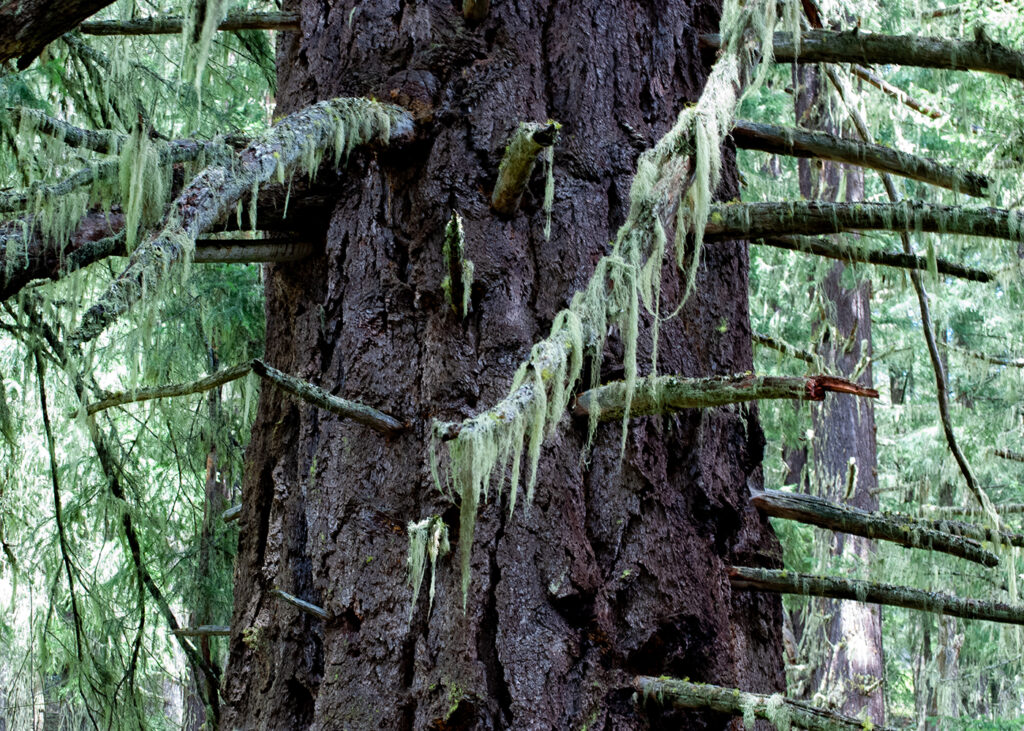
An 800-year-old Douglas fir, called the Grandmother Tree, draped in thick moss.
In May, Jackson visited an 800-year-old Douglas fir called the Grandmother Tree for the first time since the U.S. government gave the Cow Creek Umpqua back some of their land. The tree is a few miles away from where Christensen and the Tribe’s forestry team have been restoring the meadows.
So far, finding a time to burn has been tough. Challenges like climate variability from season to season limit how much they can burn each year. But near the grandmother tree that day, there was a glimpse of what’s to come.
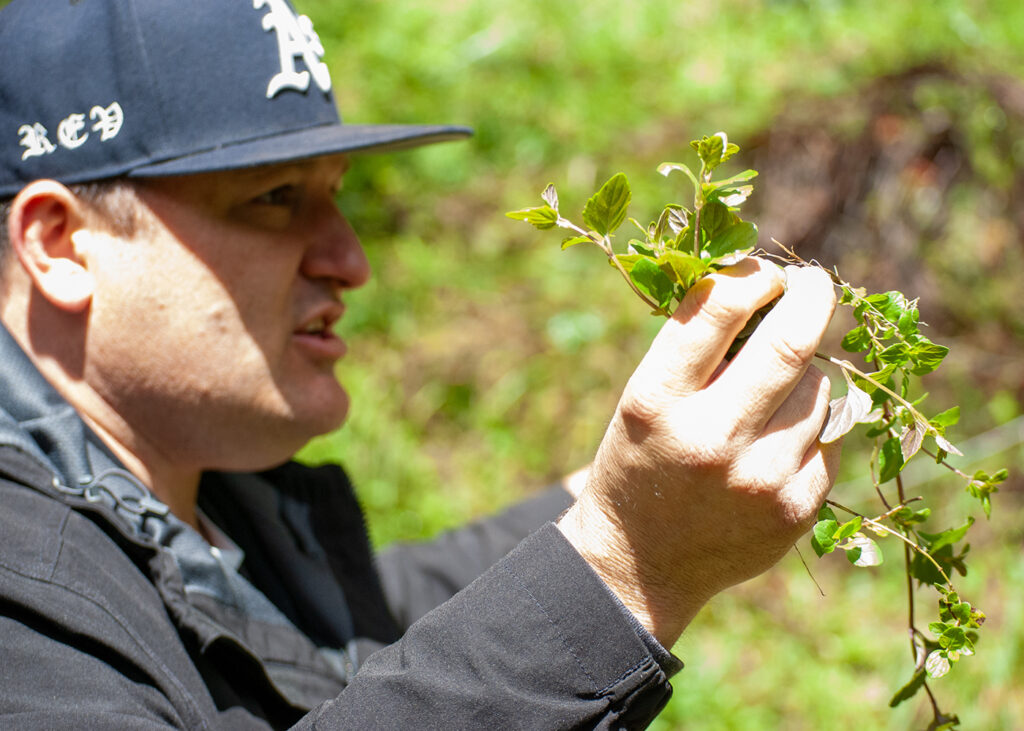
Jackson holds Yerba Buena, a medicinal plant that returns with fire. The plant needs abundant light to grow, like the wild strawberries near where Jackson found this herby bunch.
Jackson turned to a patch of wild strawberries and pulled out a leafy green that smelled like a mix of eucalyptus and mint. The plant in his hands is native to the Pacific Northwest and commonly known by its Spanish name, yerba buena, which means “good herb.” Jackson, whose grandmother Dolla was one of the last medicine women and healers in the Tribe, called it a perfect example of a medicinal plant that returns with fire, growing abundantly in sunlight.
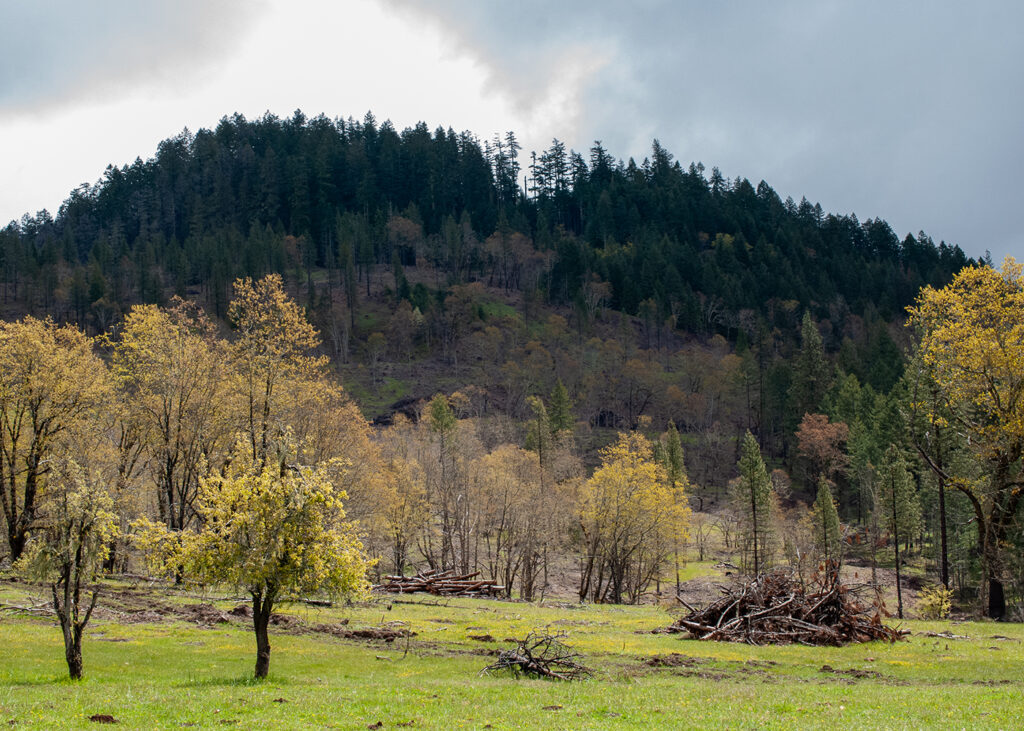
A restored oak savanna meadow with piles of trees removed as part of ongoing restoration and thinning practices.
As Jackson’s traditional ecological knowledge tells him, this is the kind of growth the landscape will see again as the Cow Creek Umpqua manage fire for open and clear savannas, benefiting the land and people there for generations to come.
This story was produced in collaboration with Next City. Reporting for this story was made possible with a fellowship from the nonprofit Institute for Journalism and Natural Resources.
This article originally appeared in Yes! Magazine at https://www.yesmagazine.org/environment/2024/09/23/fire-land-oregon-forest-native.
Yes! Magazine is a nonprofit, independent media organization dedicated to telling stories of … . Learn more at Yes! Magazine





